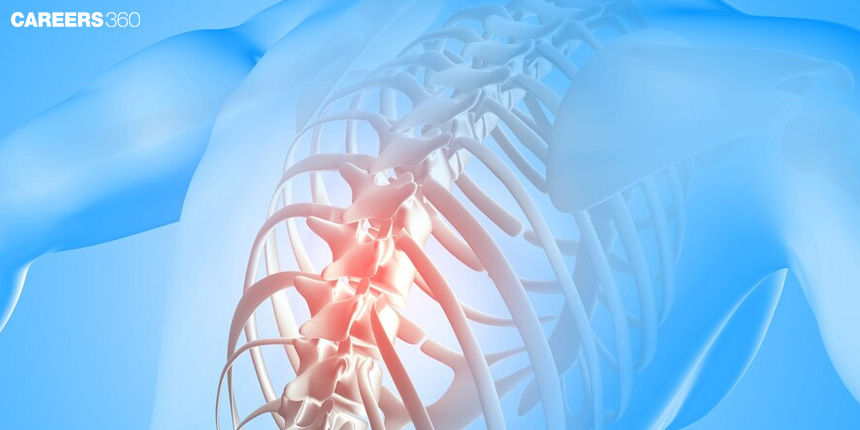Difference Between Spinal Cord and Backbone: Function, Parts, Segments
The spinal cord and backbone are crucial components of the human body, providing structural support and facilitating communication between the brain and the rest of the body. The backbone, or vertebral column, protects the delicate spinal cord while enabling flexibility and movement. The spinal cord serves as a highway for nerve signals, controlling reflex actions and transmitting sensory and motor information. In this article, the spinal cord, backbone, and differences between the spinal cord and backbone are discussed. Differences between the spinal cord and backbone are a topic of the chapter Neural Control and Coordination in Biology.
NEET 2025: Mock Test Series | Syllabus | High Scoring Topics | PYQs
NEET Important PYQ's Subject wise: Physics | Chemistry | Biology
New: Meet Careers360 B.Tech/NEET Experts in your City | Book your Seat now
- What is the Spinal Cord?
- What is the Backbone?
- Differences Between Spinal Cord and Backbone

What is the Spinal Cord?
The spinal cord is the part of the central nervous system that goes along from the brainstem to the vertebral column. It offers a pathway of nerve signals between the brain and the rest of the body in such a way that sensory inputs reach the brain and responses in the form of commands reach muscles and organs.
Anatomically, the spinal cord is cylindrical, surrounded and protected by the vertebrae and their layers of the meninges, which are important for protection. The figure of the spinal cord highlights the segmented anatomy of the cord formed by the grey matter that houses the cell bodies of the nerve cells and the white matter held by the axons of the nerve cells.
The spinal cord also functionally maintains simple and complex reflex actions, a knee-jerk reflex being an excellent example supported by it, while it also mediates autonomic functions, among which bladder control and temperature regulation are excellent examples. These give an essential dimension altogether to the spine insofar as the capabilities of functioning of the nervous system are concerned.
What is the Backbone?
The backbone is also referred to as the vertebral column or spine, constituting therefore a vital part of the skeletal system in the body that serves as a supportive and protective vault to the spinal cord. Anatomically it consists of a sequence of 33 vertebrae aligned in column fashion, categorically termed cervical, thoracic, lumbar, sacral, and coccygeal. Every two vertebrae are separated by an intervertebral disc which can function as a "shock absorber". A backbone extends from the base of the skull to the pelvis, providing structure, flexibility of movement, and maintenance of upright body position.
Segmented nature or structure and curvature in type backbones are skeletal features in a human backbone given in typical form in the diagram below. Functionally, the backbone is responsible for the protection of the spinal cord, supporting the weight and movement of the body, and playing an integral role in the attachment of muscles and ligaments in the body—essentially, a responsible feature in as far as the role of the human skeletal system about the performance of protection and motion is concerned.
Also Read-
- MCQ practice on Spinal Cord
- Neural Control And Coordination
- Control and Coordination
- Central Nervous System
Differences Between Spinal Cord and Backbone
It is one of the most important differences and comparison articles in biology. The differences are listed below-
Feature | Spinal Cord | Backbone |
Composition | Nervous tissue | Bone |
Sections | Spinal segments (cervical, thoracic, lumbar, sacral) | Vertebrae (cervical, thoracic, lumbar, sacral, coccygeal) |
Protective Layers | Meninges (dura mater, arachnoid mater, pia mater) | |
System | Nervous system | Skeletal system |
Primary Functions | Signal transmission | Structural support |
Signal Transmission | Relays nerve signals between the brain and body | Provides framework and support for the body |
Reflex Actions | Facilitates simple and complex reflexes | Protects the spinal cord from injury |
Coordination of Body Functions | Coordinates sensory and motor functions | Enables flexibility and movement |
Also Read-
Recommended video on the Difference Between the Spinal Cord and Backbone
Frequently Asked Questions (FAQs)
The spinal cord refers to that bundle of nervous tissue used by the brain and the remainder of the body in communicating. The backbone is just the series of bones that surround the spinal cord and protect it in the body.
The backbone provides complete protection to the spinal cord; the spinal cord surrounds it. Individual vertebrae join together, forming a complete channel, so the spinal column can resist most forms of physical insult.
It includes multiple sclerosis, spinal cord tumours, spinal stenosis, transverse myelitis, and amyotrophic lateral sclerosis (ALS).
Symptoms of a disorder of the backbone may include pain in the back, rigidity, reduced flexibility, numbness or tingling in the body parts, and some severe cases, weakness, bowel, and bladder control.
Some other practices to maintain a healthy spine include good posture; regular exercises; keeping a constant, healthy body weight; proper lifting, with good spinal cord and backbone health; not smoking, and sufficient intake of calcium and vitamin D to keep bones healthy. Regular check-ups with health providers can also help detect and manage problems in the early stage.
Also Read
30 Nov'24 10:55 AM
29 Nov'24 08:48 PM
29 Nov'24 06:52 PM
29 Nov'24 05:35 PM